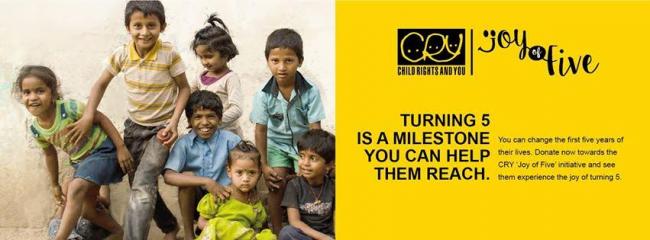
Union Budget ignores non-voting population: CRY
With health and education forming an integral part of the nine pillars for transformation of India, the scope for redrawing the future of India, and especially, its children was tremendous the NGO said.
However, the trend of decreasing share of child budgets within the social sector has continued with this year’s Union Budget. Over the years, allocations for children have failed to regain the lost ground since 2011-12 and 2012-13 when it crossed the figure of 5 per cent of the Union Budget. Instead, child budget shares have steadily decreased over the past few years, though this year has seen a marginal increase of 0.06 per cent over 2015-16 (figure 1).
In 2016-17, share of child budget stands at 3.32 percent of the Union Budget, with absolute amount increasing from Rs. 58016.72 crores (Budget Estimate 2015-16) to Rs. 65758.45 (Budget Estimate 2016-17). It may be noteworthy to remember that as part of the financial devolution to states in the previous year, social sector allocations had sharply dipped, with allocations in schemes such as Integrated Child Development Scheme and Rashtriya Madhyamik Shiksha Abhiyan by 30 per cent and more.
The ICDS scheme allocations were, in fact, increased from Rs. 8335.7 crore to Rs. 15483.77 courtesy supplementary grants released in December 2015. This year again, a reduction of Rs. 1483.77 crore has been made in the scheme. Once again, within the Child Budget allocations in 2016-17 (BE), the maximum share has been allocated to Child education at 72.22 per cent followed by Child Development with a share of 22.87 per cent. Child Health and Child Protection get the remaining share of 3.59 and 1.32 percent respectively.
Within education, amounts for Sarv Shiksha Abhiyan have been retained on a sustaining pace, with significant increases in Mid Day Meal Scheme (Rs. 464 crores) and Kendriya Vidyalaya and Navodaya Vidyalayas receiving the bulk of the increased amounts.
In child health, allocation went up from Rs. 2270.49 crore to Rs. 2359.89 crore. Approximately 90 per cent of this amount is towards implementation of the NRHM – RCH (Reproductive and Child Health) scheme which is an umbrella scheme including other expenditure related components not directed to children.
Trends in child malnutrition care, though improving, are nowhere near recovery. In the latest partial release survey results of NFHS IV shows that the status of nutrition for children under five has only marginal improvement.
While both the proportion of underweight and stunted (low height for age) children has seen a decline, the proportion of wasted children has increased in 6 of the 11 states. (West Bengal, Uttarakhand, Haryana, Karnataka, Goa and Sikkim). The operationalization of the National Nutrition Mission, delayed over the past couple of years, holds much promise for the early childhood period that is most critical for development.
Child Protection too, was not high on the radar even with increasing anxieties and expectations related to child safety and an enabling environment for children.
The Integrated Child Protection scheme which includes adoption, foster care, all child care institutions, and initiatives related to children in conflict with law, can do with intensive investments that have never been provided for setting up of a truly enabling environment for children who may be in vulnerable situations, or those who need to be diverted from accentuating circumstances that may lead them wayward.
The new Juvenile Justice Act 2015 will place much strain on the existing child protection framework and the implementing agencies.
There has been a minor reduction of Rs. 5 crores in the scheme, illustrating our lack of involvement, as a society with vulnerable and marginalized children who emerge from these very inequities within the societal framework.
Support Our Journalism
We cannot do without you.. your contribution supports unbiased journalism
IBNS is not driven by any ism- not wokeism, not racism, not skewed secularism, not hyper right-wing or left liberal ideals, nor by any hardline religious beliefs or hyper nationalism. We want to serve you good old objective news, as they are. We do not judge or preach. We let people decide for themselves. We only try to present factual and well-sourced news.







